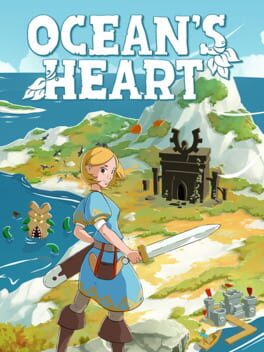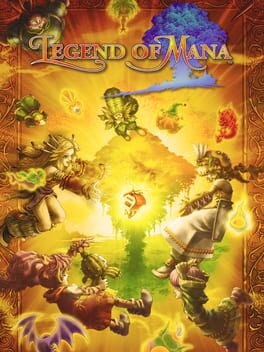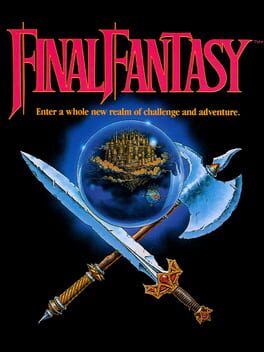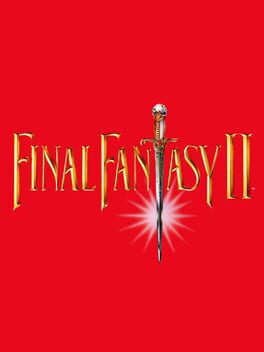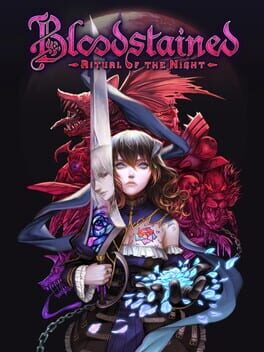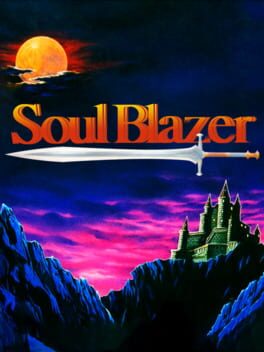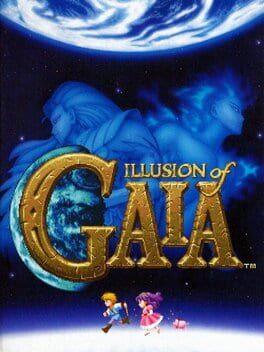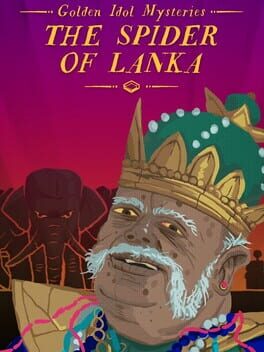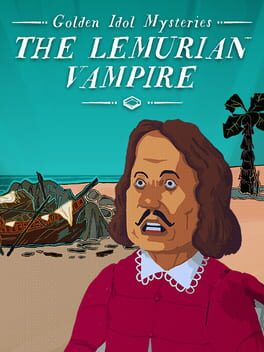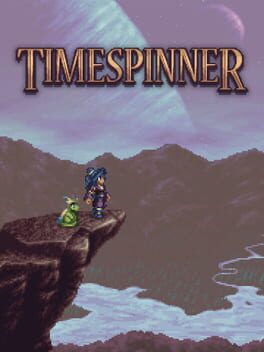whoshotvr
2021
I had an itch for a blue sky RPG, and after replaying the first half of the Ys III remake and Ys VI, I went to start Legend of Mana again, only to find this on sale, so I took a chance. And it's a 100% totally just okay Zelda love letter that wants to be Link to the Past but plays more like the first Legend of Zelda.
It's hard to be mad at it because I felt the love in this, and seeing the very short credits appreciated how much work just a few people did.
That said, it can be incredibly frustrating and a little polish would help. For instance, it's really easy to fall in the water on accident, the "interact" button is also the "roll" button, so I frequently rolled when trying to talk to someone, and boss fights are uninspired. The game also ends with a whimper.
It is gorgeous, with beautiful sprite work and a lovely score, the dungeon design is solid, and the writing is clever and fun. There are lots of areas to explore and lots of side quests that are actually fun to complete. I'd guess I finished the game with ~90% of it complete (I had 15 hearts, I think, had completed 30 side quests, with one left incomplete, and had two gaps in my inventory screen), so clearly it was charming enough that I wanted to keep going.
It's hard to be mad at it because I felt the love in this, and seeing the very short credits appreciated how much work just a few people did.
That said, it can be incredibly frustrating and a little polish would help. For instance, it's really easy to fall in the water on accident, the "interact" button is also the "roll" button, so I frequently rolled when trying to talk to someone, and boss fights are uninspired. The game also ends with a whimper.
It is gorgeous, with beautiful sprite work and a lovely score, the dungeon design is solid, and the writing is clever and fun. There are lots of areas to explore and lots of side quests that are actually fun to complete. I'd guess I finished the game with ~90% of it complete (I had 15 hearts, I think, had completed 30 side quests, with one left incomplete, and had two gaps in my inventory screen), so clearly it was charming enough that I wanted to keep going.
2021
Started this one up again, with the intent to use a guide to actually see everything this time, but I fucked it up really early on and ended up just playing this through normally. Maybe next time!
I love how there are all these obtuse, unexplained systems at play here (making instruments/weapons/golems, raising monsters, mana being cultivated on the board), but you don't actually need to use any of them at all. But if you figure them out, the deep dive is so satisfying.
I still love the three or four main stories that make up this game, and even though it's really clunky, I love how much of this game feels like you stumbled onto something on accident. It's a lovely feeling, and one I don't think you could mimic today. Back in 1999, when there was really only GameFaqs and strangers figuring things out for you, this was a revelatory casual game that slowly became something serious.
Plus, it's so cozy and beautiful. I want to live in that house and go to Domina for my groceries, maybe take a trip to Lumina for the weekend.
I love how there are all these obtuse, unexplained systems at play here (making instruments/weapons/golems, raising monsters, mana being cultivated on the board), but you don't actually need to use any of them at all. But if you figure them out, the deep dive is so satisfying.
I still love the three or four main stories that make up this game, and even though it's really clunky, I love how much of this game feels like you stumbled onto something on accident. It's a lovely feeling, and one I don't think you could mimic today. Back in 1999, when there was really only GameFaqs and strangers figuring things out for you, this was a revelatory casual game that slowly became something serious.
Plus, it's so cozy and beautiful. I want to live in that house and go to Domina for my groceries, maybe take a trip to Lumina for the weekend.
Technically I played this on the Switch NES Emulator. Full disclosure: I rewound a LOT.
I am about ready to go finish Tears of the Kingdom. I've done ~75% of the game, all the shrines, all the lights, most of the quests, all the stuff that I loved the most. I just need a dedicated two hour chunk to get in there and wrap that thing up. So of course instead of doing that, I played Zelda 2.
It's nearly impossible to actually rate Adventure of Link in 2023 because it exists outside of its context, and its context matters.
It's hard to remember that there used to be a time when there were no video game sequels. At that point, a few arcade games had sequels. You had your Ms Pac-Man and Stargate, but all those did were take the originals and add a new system or two. Ms Pac-Man added new mazes. That's it.
Zelda 2 was the first of the NES sequels in America (Japan got Real Mario 2 in 1986), and it blew our little minds. We didn't know what a sequel to Zelda would look like, let alone a sequel to any of the games we'd been playing. How do you make a new Zelda?
Well, the answer is you make something completely new, and for what this game is, it is pretty amazing. Yes, it's infuriatingly difficult, yes it's incredibly unfair, yes I never beat it as a child (friends did, and sometimes that was enough back then).
Zelda 2 tries to create a swordfighting focused video game. Instead of being able to swing your sword around wildly, you have to calculate the right time and level (high or low) to strike.
The world is much bigger than the Hyrule of the first game, but it's also much more fluid. Items you find in dungeons aren't meant to be used in the field, they are all keys to doors, and the flow is really elegant.
To get to the first dungeon, you have to go through a dark cave. There's a single beastie in there that you can't see, so you navigate the dark cave and take a single hit. You learn that the dark is bad (if you managed to miss this cave and explore too far, you'll find another dark cave that is much longer, nudging you back to the path). The first dungeon gives you the candle, which opens up the next cave, to a point.
You can't actually get through the second cave without the Jump spell, and to get that, you have to explore the limited world you have available to you to find a trophy. Someone in the second town needs that trophy, and once you give it to them, you get the Jump spell. This teaches you that people in town want things that will give you other things.
The whole game continues like this. It's really elegant design. Go to a place, get a thing, trade it for a spell, get to the dungeon, get the item, open the path to the next place.
What I truly love about the world map in Zelda 2 is that, once you get through it, it takes no time at all to get from one side to the other. The longest path is from the Temple to Death Mountain, because you have to go through the cave, then the swamp, but even that isn't long. After Death Mountain, the hammer will take you from the Temple to the Raft dock in under a minute.
Palace design is not as obtuse as the Dungeon designs of the first game, with fewer hidden or one-way paths, and the many forked paths encourage map drawing. Within the palaces are some solid platforming puzzles, ones that encourage magic use for full navigation. Enough enemies drop magic jars and there are a few red jars within each palace that you don't need to be too careful (but do be KIND OF careful!) with your magic use.
The escalation in the enemies is very well done too. Initially you meet slow moving guys that don't really stalk. This turns to quicker guys with weapons, then guys that can block, then faster guys that can block, then guys who throw but you can block, then guys who throw that you can't block, then guys who throw that you can't block but their <i>weapon comes back</>, then guys who block and throw and jump.
This is really where the design falters, because these guys are really fucking infuriating. They move fast and can block almost anything you try, so fights towards the end get tedious and are incredibly unfair (again, I rewound a LOT), but again, it was 1987 and this was the first sequel ever. They tried something new with very limited resources.
And that's another thing! The NES couldn't do a lot! Battery saves were a huge deal, but all they could save was player status and inventory. It's why these games don't start you back from where you left off, why you have to go back to the Temple when you get a Game Over or when you reset the game.
But within those restrictions, Nintendo was able to create eight very large temples, an overworld, multiple types of building exteriors and interiors, five different types of random battle areas (field, forest, desert, swamp, road) with four of those offering multiple enemy sets, including hard variants when you hit a big monster.
This game is an impressive achievement that is very easy to dismiss almost 40 years later because nothing on the NES aged well. I'll still play this again before I replay Skyward Sword.
I am about ready to go finish Tears of the Kingdom. I've done ~75% of the game, all the shrines, all the lights, most of the quests, all the stuff that I loved the most. I just need a dedicated two hour chunk to get in there and wrap that thing up. So of course instead of doing that, I played Zelda 2.
It's nearly impossible to actually rate Adventure of Link in 2023 because it exists outside of its context, and its context matters.
It's hard to remember that there used to be a time when there were no video game sequels. At that point, a few arcade games had sequels. You had your Ms Pac-Man and Stargate, but all those did were take the originals and add a new system or two. Ms Pac-Man added new mazes. That's it.
Zelda 2 was the first of the NES sequels in America (Japan got Real Mario 2 in 1986), and it blew our little minds. We didn't know what a sequel to Zelda would look like, let alone a sequel to any of the games we'd been playing. How do you make a new Zelda?
Well, the answer is you make something completely new, and for what this game is, it is pretty amazing. Yes, it's infuriatingly difficult, yes it's incredibly unfair, yes I never beat it as a child (friends did, and sometimes that was enough back then).
Zelda 2 tries to create a swordfighting focused video game. Instead of being able to swing your sword around wildly, you have to calculate the right time and level (high or low) to strike.
The world is much bigger than the Hyrule of the first game, but it's also much more fluid. Items you find in dungeons aren't meant to be used in the field, they are all keys to doors, and the flow is really elegant.
To get to the first dungeon, you have to go through a dark cave. There's a single beastie in there that you can't see, so you navigate the dark cave and take a single hit. You learn that the dark is bad (if you managed to miss this cave and explore too far, you'll find another dark cave that is much longer, nudging you back to the path). The first dungeon gives you the candle, which opens up the next cave, to a point.
You can't actually get through the second cave without the Jump spell, and to get that, you have to explore the limited world you have available to you to find a trophy. Someone in the second town needs that trophy, and once you give it to them, you get the Jump spell. This teaches you that people in town want things that will give you other things.
The whole game continues like this. It's really elegant design. Go to a place, get a thing, trade it for a spell, get to the dungeon, get the item, open the path to the next place.
What I truly love about the world map in Zelda 2 is that, once you get through it, it takes no time at all to get from one side to the other. The longest path is from the Temple to Death Mountain, because you have to go through the cave, then the swamp, but even that isn't long. After Death Mountain, the hammer will take you from the Temple to the Raft dock in under a minute.
Palace design is not as obtuse as the Dungeon designs of the first game, with fewer hidden or one-way paths, and the many forked paths encourage map drawing. Within the palaces are some solid platforming puzzles, ones that encourage magic use for full navigation. Enough enemies drop magic jars and there are a few red jars within each palace that you don't need to be too careful (but do be KIND OF careful!) with your magic use.
The escalation in the enemies is very well done too. Initially you meet slow moving guys that don't really stalk. This turns to quicker guys with weapons, then guys that can block, then faster guys that can block, then guys who throw but you can block, then guys who throw that you can't block, then guys who throw that you can't block but their <i>weapon comes back</>, then guys who block and throw and jump.
This is really where the design falters, because these guys are really fucking infuriating. They move fast and can block almost anything you try, so fights towards the end get tedious and are incredibly unfair (again, I rewound a LOT), but again, it was 1987 and this was the first sequel ever. They tried something new with very limited resources.
And that's another thing! The NES couldn't do a lot! Battery saves were a huge deal, but all they could save was player status and inventory. It's why these games don't start you back from where you left off, why you have to go back to the Temple when you get a Game Over or when you reset the game.
But within those restrictions, Nintendo was able to create eight very large temples, an overworld, multiple types of building exteriors and interiors, five different types of random battle areas (field, forest, desert, swamp, road) with four of those offering multiple enemy sets, including hard variants when you hit a big monster.
This game is an impressive achievement that is very easy to dismiss almost 40 years later because nothing on the NES aged well. I'll still play this again before I replay Skyward Sword.
1987
This review contains spoilers
Full Disclosure: I played through this will full on Game Genie cheats because I wanted to experience it without having to experience it the way I did when I was 10.
Like with my review of Zelda 2, there is no way to accurately explain what it was like playing this in 1990. When this came out, we had played through Dragon Warrior numerous times (everyone had that game, in part because Nintendo Power gave it away (my childless uncle got me whatever game Toys 'R Us said was the best every Christmas, which was how I got it)) and Dragon Warrior 2, and we fought their limitations and quirks.
But Final Fantasy was different. It was bigger, it came with maps and monster guides (because we weren't as good at video games as Japanese kids were), and you got FOUR characters!
It had its own limitations, however, like how you could only save in towns or on the field with an item, and how you always had to walk out of caves or dungeons and then all the way back to town, making every single trek terrifying.
Here was our loop: grind, buy the best stuff, overlevel, run away from every battle in dungeons, beat the boss/get the thing, run away from every battle on the way back, breathe a sigh of relief back in town (one time, only our White Mage was still alive and we stupidly saved with a HOUSE outside the Marsh Cave (there was only one save file) and it took us dozens of tries to make it back to town).
But what really made this game great, what really made it stand above the rest, was the story. On the surface, it is very bare bones, yes, but it has a lot of variety, and there are, for the time, remarkable moments of wonder and depth.
The moment that I still refer back to when explaining this is the Waterfall Cave. At this point in the game, you should have three orbs lit and an airship. You have walked through a very dangerous forest to Lemuria, and you have figured out how to speak their language, because they are an advanced and ancient people.
In the cave, there is a robot. Why is there a robot here?!? That robot gives you a cube, which will take you to the Space Castle. Why is there a Space Castle?!?
In 1990, this blew our minds. The PS1 remake tragically changed the decrepit, metal Space Castle into a regular castle, removing that feeling of wonder that came from going from a medieval setting to a futuristic one in a single move.
And then, at the end, you have to, in a single run, go 2000 years in the past and refight all four fiends and THEN the final boss. This took us numerous tries, and when we finally delivered the killing blow, with a near death Black Wizard, we jumped on those fucken beds and cheered and yelled like idiots.
And you just can't get that feeling anymore, but I sure as hell have been trying, through practically every entry in the series.
Like with my review of Zelda 2, there is no way to accurately explain what it was like playing this in 1990. When this came out, we had played through Dragon Warrior numerous times (everyone had that game, in part because Nintendo Power gave it away (my childless uncle got me whatever game Toys 'R Us said was the best every Christmas, which was how I got it)) and Dragon Warrior 2, and we fought their limitations and quirks.
But Final Fantasy was different. It was bigger, it came with maps and monster guides (because we weren't as good at video games as Japanese kids were), and you got FOUR characters!
It had its own limitations, however, like how you could only save in towns or on the field with an item, and how you always had to walk out of caves or dungeons and then all the way back to town, making every single trek terrifying.
Here was our loop: grind, buy the best stuff, overlevel, run away from every battle in dungeons, beat the boss/get the thing, run away from every battle on the way back, breathe a sigh of relief back in town (one time, only our White Mage was still alive and we stupidly saved with a HOUSE outside the Marsh Cave (there was only one save file) and it took us dozens of tries to make it back to town).
But what really made this game great, what really made it stand above the rest, was the story. On the surface, it is very bare bones, yes, but it has a lot of variety, and there are, for the time, remarkable moments of wonder and depth.
The moment that I still refer back to when explaining this is the Waterfall Cave. At this point in the game, you should have three orbs lit and an airship. You have walked through a very dangerous forest to Lemuria, and you have figured out how to speak their language, because they are an advanced and ancient people.
In the cave, there is a robot. Why is there a robot here?!? That robot gives you a cube, which will take you to the Space Castle. Why is there a Space Castle?!?
In 1990, this blew our minds. The PS1 remake tragically changed the decrepit, metal Space Castle into a regular castle, removing that feeling of wonder that came from going from a medieval setting to a futuristic one in a single move.
And then, at the end, you have to, in a single run, go 2000 years in the past and refight all four fiends and THEN the final boss. This took us numerous tries, and when we finally delivered the killing blow, with a near death Black Wizard, we jumped on those fucken beds and cheered and yelled like idiots.
And you just can't get that feeling anymore, but I sure as hell have been trying, through practically every entry in the series.
1991
I was very excited for this game when I first read about it in Nintendo Power, but never actually ended up owning it. I got a SNES not long after this came out, but it never got on my wishlists (Final Fantasy Mystic Quest did... maybe I'll replay that one soon...).
Because I rented this instead of owned it, for many years, I only ever made it to the dolls, which feels like it should be halfway through, but is instead only about a third. Eventually, I borrowed it from a friend and completed it, some time after Final Fantasy III came out, and after playing (and replaying) FF III, this one was a bit rough...
At the time, as we didn't get FF II or III, this did feel like a second entry in the series. It referred back to the first entry plenty, but within a completely, unrelated story. We got the four fiends, we got the music and scrolling text post-prologue, we got the rat tail, we got the vehicles, we got the crystals, it was all there.
But this time, there was also MORE! A LOT more! And while much of that "more" is clumsy, at least they tried to really push the SNES to its limits (its 1991 limits, at least).
There are a ton of playable characters, but they come and go, and sometimes never come back. Plot points are raced through in order to get to the next section or story beat, and then sometimes they just draaaaaag (the robot walking just takes for fucking ever).
But it's beautiful and the music is great, and there's no way to actually describe what it was like to see everything we loved from the first entry, but in 16 bits. It was revelatory.
I will say, while the DS complete remake of this entry is much better in just about every way, I prefer this version for one reason: The Tower of Zot/Babel. For whatever stupid reason, Square started to undo the sci-fi elements they put into their entries. The Tower of Zot was like the flying castle in the first game: a sudden surprise. Here we are in this fantasy world, and suddenly there's future tech (see also: Might and Magic III)? That was a shock, and Square just made the tower into a brown, dusty tower. Boring as shit.
Because I rented this instead of owned it, for many years, I only ever made it to the dolls, which feels like it should be halfway through, but is instead only about a third. Eventually, I borrowed it from a friend and completed it, some time after Final Fantasy III came out, and after playing (and replaying) FF III, this one was a bit rough...
At the time, as we didn't get FF II or III, this did feel like a second entry in the series. It referred back to the first entry plenty, but within a completely, unrelated story. We got the four fiends, we got the music and scrolling text post-prologue, we got the rat tail, we got the vehicles, we got the crystals, it was all there.
But this time, there was also MORE! A LOT more! And while much of that "more" is clumsy, at least they tried to really push the SNES to its limits (its 1991 limits, at least).
There are a ton of playable characters, but they come and go, and sometimes never come back. Plot points are raced through in order to get to the next section or story beat, and then sometimes they just draaaaaag (the robot walking just takes for fucking ever).
But it's beautiful and the music is great, and there's no way to actually describe what it was like to see everything we loved from the first entry, but in 16 bits. It was revelatory.
I will say, while the DS complete remake of this entry is much better in just about every way, I prefer this version for one reason: The Tower of Zot/Babel. For whatever stupid reason, Square started to undo the sci-fi elements they put into their entries. The Tower of Zot was like the flying castle in the first game: a sudden surprise. Here we are in this fantasy world, and suddenly there's future tech (see also: Might and Magic III)? That was a shock, and Square just made the tower into a brown, dusty tower. Boring as shit.
Completely and totally okay, just perfect fine, right there in the middle, laying there, not really doing anything special.
I had a hankering for a good SOTN clone, but as I had just replayed it a year or so ago and recently replayed all the GBA ones, I didn't really want to go back to those quite yet. This was on sale and I had some credit, so it ended up being $5, and I'd say it's worth about that.
It's appropriately gothic, sexy, horny, violent, and IGA, completely and totally IGA, so that was nice. It's also like an Asylum version of Castlevania, called... maybe... CastleMANIA. It's got everything. There's a Belmont you can fight, and a boss that throws sickles and teleports. There's a chapel and a clock tower, a soul collecting system like in the future sky castle ones, lots of weapons to play with, and tons of food. It's basically Less Good SOTN, and that's okay!
But it's not SOTN. Your character moves like a real turd. Not quite like a classic Belmont, but she's slow and her backstep doesn't always work. The music is all fine, but none of it is memorable, and I ended up listening to podcasts for a lot of the endgame, where in SOTN, I'm always into that soundtrack. The graphics do not look good, all shiny and rounded in weird ways. Even the backgrounds that are supposed to provide the illusion of this castle stretching on forever look flat and weird.
There is also a LOT of grinding that you have to do to succeed, because most of the bosses are frustrating and a few areas have huge difficulty spikes (if you love grinding and you did all the grinding to get all shards to 9 and all the food etc, more power to you, but god damn I just can't imagine doing that).
They frequently move faster than you, have short tells, hit hard, and often require more than one try to figure them out. This is fine for SOME bosses, but in Bloodstained, this is true of all of them, including the first one. You never get that feeling of being okay enough at the game to feel successful, and even by the end I always felt irritated coming across a boss door. I was supposed to feel anxiety mixed with confidence, but instead, I was already mad about a boss fight before it had even started.
There are just so many weird places that the designers seemed to turn their brains off. The passport is a perfect example. At no time is it set up for the player that the people you meet may have pertinent information for you. Dominque and Johannes sometimes tell you stuff after you visit them, but the none of the other villagers ever talk about anything besides their quests. So how I was supposed to even think that Alucard was going to give me a passport if I had a photograph of myself? It's insane, NES era logic, which is inexcusable in a game that has endless memory and space for scripts and hints. And that's just the start.
Special moves require more perfect precision, rendering them useless. invert does as well, which pushed me to the D-pad to make sure I could pull it off more than 50% of the time. There are an endless amount of weapons, but most of them never have a reason to be used. Why would I use boots for anything when they are never as strong as a faster weapon with longer distance? In SOTN, the punch weapons felt like they were included because someone had fun programming it in, and it was the beginning of a new era of programming, so they were just tucked away in there. But here, they feel like they are here because, well SOTN had punching so we have to too!
But they DON'T have to too! All they had to do was make a good game, but they were too focused on making a game that had already been made that they just couldn't pull it off. In comparison, the Record of Lodoss War game that came out a few years back was not only an excellent SOTN clone, it was shorter and tighter, offering an evolution of the form.
Bloodstained is regressive and irritating, an attempt to be something that already exists instead of being something fresh that reminds us of that thing that already exists. Like how the Castelvania III Bloodstained game was! That was a fresh, new, tightly programmed game that made me remember Castlevania III without being beholden to Castlevania III! And that's what I was hoping this would be. Oh well.
I had a hankering for a good SOTN clone, but as I had just replayed it a year or so ago and recently replayed all the GBA ones, I didn't really want to go back to those quite yet. This was on sale and I had some credit, so it ended up being $5, and I'd say it's worth about that.
It's appropriately gothic, sexy, horny, violent, and IGA, completely and totally IGA, so that was nice. It's also like an Asylum version of Castlevania, called... maybe... CastleMANIA. It's got everything. There's a Belmont you can fight, and a boss that throws sickles and teleports. There's a chapel and a clock tower, a soul collecting system like in the future sky castle ones, lots of weapons to play with, and tons of food. It's basically Less Good SOTN, and that's okay!
But it's not SOTN. Your character moves like a real turd. Not quite like a classic Belmont, but she's slow and her backstep doesn't always work. The music is all fine, but none of it is memorable, and I ended up listening to podcasts for a lot of the endgame, where in SOTN, I'm always into that soundtrack. The graphics do not look good, all shiny and rounded in weird ways. Even the backgrounds that are supposed to provide the illusion of this castle stretching on forever look flat and weird.
There is also a LOT of grinding that you have to do to succeed, because most of the bosses are frustrating and a few areas have huge difficulty spikes (if you love grinding and you did all the grinding to get all shards to 9 and all the food etc, more power to you, but god damn I just can't imagine doing that).
They frequently move faster than you, have short tells, hit hard, and often require more than one try to figure them out. This is fine for SOME bosses, but in Bloodstained, this is true of all of them, including the first one. You never get that feeling of being okay enough at the game to feel successful, and even by the end I always felt irritated coming across a boss door. I was supposed to feel anxiety mixed with confidence, but instead, I was already mad about a boss fight before it had even started.
There are just so many weird places that the designers seemed to turn their brains off. The passport is a perfect example. At no time is it set up for the player that the people you meet may have pertinent information for you. Dominque and Johannes sometimes tell you stuff after you visit them, but the none of the other villagers ever talk about anything besides their quests. So how I was supposed to even think that Alucard was going to give me a passport if I had a photograph of myself? It's insane, NES era logic, which is inexcusable in a game that has endless memory and space for scripts and hints. And that's just the start.
Special moves require more perfect precision, rendering them useless. invert does as well, which pushed me to the D-pad to make sure I could pull it off more than 50% of the time. There are an endless amount of weapons, but most of them never have a reason to be used. Why would I use boots for anything when they are never as strong as a faster weapon with longer distance? In SOTN, the punch weapons felt like they were included because someone had fun programming it in, and it was the beginning of a new era of programming, so they were just tucked away in there. But here, they feel like they are here because, well SOTN had punching so we have to too!
But they DON'T have to too! All they had to do was make a good game, but they were too focused on making a game that had already been made that they just couldn't pull it off. In comparison, the Record of Lodoss War game that came out a few years back was not only an excellent SOTN clone, it was shorter and tighter, offering an evolution of the form.
Bloodstained is regressive and irritating, an attempt to be something that already exists instead of being something fresh that reminds us of that thing that already exists. Like how the Castelvania III Bloodstained game was! That was a fresh, new, tightly programmed game that made me remember Castlevania III without being beholden to Castlevania III! And that's what I was hoping this would be. Oh well.
After the Just Okay Bloodstained, I thought I'd play through IGA's actual masterpiece for the 20th time. I also played through it on the luck build for the first time, which lowers all stats to almost nothing, except for luck, which is at 99 + 20.
And it was actually hard again! Harder than the very first time, 26 years ago. Wargs in the opening hallway kill in one hit! The bone tossing skeletons in the Alchemist's Laboratory killed me in three! I saw the Game Over screen more often in that first hour than I had since 1997! It was great!
But high luck also means you find all kinds of cool shit, including rare weapons and armor, and by the time I was at the Outer Wall, I was regular strength again. I did have to rethink how to play, because I'd never played with fists before and my best weapon by far were the jeweled knuckles, so it was still fun.
By the end, I had the Crissagrim and 90% of attacks were just taking a single hit point away, so I pretty much ruled. It was still really fun to play through again, because it always is, even if the new localization and voices are all wrong.
I wish I could put that and the shitty Kenny G credits song back, but I also get that this is pure nostalgia and that those things were objectively awful.
And it was actually hard again! Harder than the very first time, 26 years ago. Wargs in the opening hallway kill in one hit! The bone tossing skeletons in the Alchemist's Laboratory killed me in three! I saw the Game Over screen more often in that first hour than I had since 1997! It was great!
But high luck also means you find all kinds of cool shit, including rare weapons and armor, and by the time I was at the Outer Wall, I was regular strength again. I did have to rethink how to play, because I'd never played with fists before and my best weapon by far were the jeweled knuckles, so it was still fun.
By the end, I had the Crissagrim and 90% of attacks were just taking a single hit point away, so I pretty much ruled. It was still really fun to play through again, because it always is, even if the new localization and voices are all wrong.
I wish I could put that and the shitty Kenny G credits song back, but I also get that this is pure nostalgia and that those things were objectively awful.
1992
Every few years I get a hankering for Link to the Past and some Zelda clones. That always involves me playing this, then most of Illusion of Gaia (I may actually finish it next time), then some of Terranigma, and maybe a Ys or two for good measure, and then I'm done.
But of all of them (besides LttP of course), this one is my favorite. As a game, it's... primitive. Gameplay is simple and feels like it's crafted to make your weapon range and easy enemy patterns make up for the original intended complexity. Your sword swing hits in a full circle around you (even if it's not animated to look like it, it does), enemies are programmed to have complex movement and attacks but generally come out of the lairs in a straight line, and there is no currency so there's no resource management (outside of a single HP recovery item you can hold).
But it also feels like Quintet wasn't interested in making a game, they were interested in making everything else. Back in 1992, these graphics were among the most beautiful I'd ever seen. I wanted to live in Grass Valley, I still do. Everything feels like it takes place in a cold, mountain sunset, which is fitting, because the game itself is about being alone and how you manage.
The core mechanic of dungeon crawling, releasing people, getting stuff from people, then returning to dungeon crawling is very satisfying, even though I've done it twenty times or more in the last 30+ years. I still love being in this game.
There's a very real sadness here, which you can really hear in the music, and even the happy ending is laced with melancholy. Characters grow and make promises they may never keep, but it doesn't matter to us, because we won't be there.
And the final bit, the close up on Lisa and the text about her growth, hits me harder the older I get, as do the dwarves who only live a year.
There's so much beauty in this little game, and so much to admire. Quintet never really got past this, and I wish they were still around, making games.
But of all of them (besides LttP of course), this one is my favorite. As a game, it's... primitive. Gameplay is simple and feels like it's crafted to make your weapon range and easy enemy patterns make up for the original intended complexity. Your sword swing hits in a full circle around you (even if it's not animated to look like it, it does), enemies are programmed to have complex movement and attacks but generally come out of the lairs in a straight line, and there is no currency so there's no resource management (outside of a single HP recovery item you can hold).
But it also feels like Quintet wasn't interested in making a game, they were interested in making everything else. Back in 1992, these graphics were among the most beautiful I'd ever seen. I wanted to live in Grass Valley, I still do. Everything feels like it takes place in a cold, mountain sunset, which is fitting, because the game itself is about being alone and how you manage.
The core mechanic of dungeon crawling, releasing people, getting stuff from people, then returning to dungeon crawling is very satisfying, even though I've done it twenty times or more in the last 30+ years. I still love being in this game.
There's a very real sadness here, which you can really hear in the music, and even the happy ending is laced with melancholy. Characters grow and make promises they may never keep, but it doesn't matter to us, because we won't be there.
And the final bit, the close up on Lisa and the text about her growth, hits me harder the older I get, as do the dwarves who only live a year.
There's so much beauty in this little game, and so much to admire. Quintet never really got past this, and I wish they were still around, making games.
1993
For whatever reason, Illusion of Gaia is always one I get halfway through and then put down. I finished it once on a rental in high school, once in college, and then once today. About halfway through it's like the designers got scared that they were building areas that were too repetitive and mixed it up, but the way they did was incredibly aggravating.
The last three big areas, Mt. Kruik Angkor Wat, and the Pyramid, are all long, confusing, and frustrating. There's no longer a clear indication of where to go, not even a little bit, rooms and screens all start to look the same, and enemies become unfair or irritating.
So it's usually around Euro that I feel like I've had enough and I'm ready to move on. The ending has been seared into my brain for almost 30 years, so it's not like I need a refresher on that. But what I had been missing was how deeply sad the back half of the game is. There are early interpersonal/character moments that are hard, but the longer the game goes on, the more horrible things it shows us about the world -- and our world. There's hope there, but there's also a deep sadness, like maybe that hope isn't going to be enough.
And today, in 2023, I felt that. It doesn't have the melancholy that Soul Blazer has, maybe because in Soul Blazer the world had already ended at the start of the game and in Illusion of Gaia the world was still fearing the end.
But we get slavery of both the child and the adult varieties, pleas for vegetarianism, cannibalism, poverty, despotism, and this admission that maybe, despite what we want to believe, it's always been this way and it will always be that way.
The closing text, over the modern city, hit hard this time, especially the bit about the earth looking sad, even as everyone on it was happy. I will likely go through Terranigma next, and I'm already thinking about the modern city section of that game and the depressed people inside it.
The last three big areas, Mt. Kruik Angkor Wat, and the Pyramid, are all long, confusing, and frustrating. There's no longer a clear indication of where to go, not even a little bit, rooms and screens all start to look the same, and enemies become unfair or irritating.
So it's usually around Euro that I feel like I've had enough and I'm ready to move on. The ending has been seared into my brain for almost 30 years, so it's not like I need a refresher on that. But what I had been missing was how deeply sad the back half of the game is. There are early interpersonal/character moments that are hard, but the longer the game goes on, the more horrible things it shows us about the world -- and our world. There's hope there, but there's also a deep sadness, like maybe that hope isn't going to be enough.
And today, in 2023, I felt that. It doesn't have the melancholy that Soul Blazer has, maybe because in Soul Blazer the world had already ended at the start of the game and in Illusion of Gaia the world was still fearing the end.
But we get slavery of both the child and the adult varieties, pleas for vegetarianism, cannibalism, poverty, despotism, and this admission that maybe, despite what we want to believe, it's always been this way and it will always be that way.
The closing text, over the modern city, hit hard this time, especially the bit about the earth looking sad, even as everyone on it was happy. I will likely go through Terranigma next, and I'm already thinking about the modern city section of that game and the depressed people inside it.
I didn't think to log this, but I should, because I played it, and it was just the best. I tried to limit myself to one case a day, and I was able to with this entry.
It's more of the same, just not that much more... The puzzles felt great, it itched my brain just right, and made me feel so smart without making it look too easy, and the story it told slid right into the main narrative perfectly.
It's more of the same, just not that much more... The puzzles felt great, it itched my brain just right, and made me feel so smart without making it look too easy, and the story it told slid right into the main narrative perfectly.
I tried to make this one last, just like with the previous entry, but I wasn't able to... I just wanted to keep going, and then before I knew it, it was all over. But what an all over!
There are new mechanics that are introduced here with no explanation, but discovering what they do is a fun little meta puzzle, one that adds a fun layer to the puzzles.
The story slips in and completes the circle, finally telling the missing piece of the story and I'm sad it's over. I am so excited to see what these people do next, and I hope they do it ASAFP.
There are new mechanics that are introduced here with no explanation, but discovering what they do is a fun little meta puzzle, one that adds a fun layer to the puzzles.
The story slips in and completes the circle, finally telling the missing piece of the story and I'm sad it's over. I am so excited to see what these people do next, and I hope they do it ASAFP.
1990
Apparently I'm on a Quintet roll instead of on a Soul Blazer trilogy roll... I had this on the SNES in college, but couldn't make it very far, because the action sequences are unforgivably clumsy.
There is a desire to excuse how bad they are by saying, "Well, it was 1990", but in 1990 we had good platformers. There's no excuse for how messy they are, because they aren't doing anything new. It's disheartening, because the rest of the game is daring.
The sim segments are fun and creative, attempting to do a light Populous thing, telling its story through the work you do for people, but without giving you the option of being a huge jerk. The only stories actually being told here are told by your worshippers, and they do feel like proto-Quintet narratives. Lost faith, the stress of being a person in a civilization, and the growth from one dying age of humanity to the next thriving age of humanity (a nice touch: Every area has a Stonehenge looking thing you enter to fight, and when you beat the monsters it becomes a Grecian/Roman looking structure).
I liberally used the rewind button on this one, and the last boss rush was a real piece of shit move, but hey. This game was a big deal in 1990, and while I didn't understand it then, at least it impacted enough people to get Quintet on the path they ended up on. I can't be mad about that.
There is a desire to excuse how bad they are by saying, "Well, it was 1990", but in 1990 we had good platformers. There's no excuse for how messy they are, because they aren't doing anything new. It's disheartening, because the rest of the game is daring.
The sim segments are fun and creative, attempting to do a light Populous thing, telling its story through the work you do for people, but without giving you the option of being a huge jerk. The only stories actually being told here are told by your worshippers, and they do feel like proto-Quintet narratives. Lost faith, the stress of being a person in a civilization, and the growth from one dying age of humanity to the next thriving age of humanity (a nice touch: Every area has a Stonehenge looking thing you enter to fight, and when you beat the monsters it becomes a Grecian/Roman looking structure).
I liberally used the rewind button on this one, and the last boss rush was a real piece of shit move, but hey. This game was a big deal in 1990, and while I didn't understand it then, at least it impacted enough people to get Quintet on the path they ended up on. I can't be mad about that.
2018
I forgot when I started this, but I got right to one final boss option and just put it down for a month or so, for no good reason. I was enjoying it, I was just done a little bit before the game was.
The boss fights were probably the weakest part, so once I got through all the exploration stuff, I didn't really feel like I had to finish it, even though I was enjoying the story.
I did finish it, though, at least the first final boss option. I did that twice to see both endings, then I went to the other ending section and that area looked to be a perpetual dungeon where the prizes for winning are just... more stuff? But I'm at the end? So I don't know that there's much of a point to that, except to get one more boss fight I'm not going to have fun doing, so I think I'm good.
But the game part of the game was great! Exploration was fun, areas were varied enough, the time travel stuff was fun, and the artwork and music were beautiful. There's a nice variety of weapons to play with, and there are lots of fun combinations to play with.
Everything has a level, the familiars, the spells, and the weapons, but they go fast and you can buy them to more quickly catch up, so it's actually fun to experiment with new tools.
The writing was a little rough here and there, and it was weird to see all the characters have their stories all be about romantic relationships with other characters, but it was fine enough.
For a little independent Metroid clone, this is a pretty good one.
The boss fights were probably the weakest part, so once I got through all the exploration stuff, I didn't really feel like I had to finish it, even though I was enjoying the story.
I did finish it, though, at least the first final boss option. I did that twice to see both endings, then I went to the other ending section and that area looked to be a perpetual dungeon where the prizes for winning are just... more stuff? But I'm at the end? So I don't know that there's much of a point to that, except to get one more boss fight I'm not going to have fun doing, so I think I'm good.
But the game part of the game was great! Exploration was fun, areas were varied enough, the time travel stuff was fun, and the artwork and music were beautiful. There's a nice variety of weapons to play with, and there are lots of fun combinations to play with.
Everything has a level, the familiars, the spells, and the weapons, but they go fast and you can buy them to more quickly catch up, so it's actually fun to experiment with new tools.
The writing was a little rough here and there, and it was weird to see all the characters have their stories all be about romantic relationships with other characters, but it was fine enough.
For a little independent Metroid clone, this is a pretty good one.
2014
I guess I should add stuff I know at this point I'll likely never get back to. I made it to the tower bit, and while that was cool, I didn't like the sudden time limit and I just walked away.
The narrative here is beautiful, the writing excellent, the design gorgeous, the puzzles... just fine. There were some brilliant puzzles, the kind that really gust me, but to many of them were "three doors, two keys", where you have to figure out how to juggle things through and around doors, and that's just not fun.
But when this game is good, it's GOOD.
The narrative here is beautiful, the writing excellent, the design gorgeous, the puzzles... just fine. There were some brilliant puzzles, the kind that really gust me, but to many of them were "three doors, two keys", where you have to figure out how to juggle things through and around doors, and that's just not fun.
But when this game is good, it's GOOD.
Just about perfect in every way, started it on the day it was released and played probably 80% of it. Got all the shrines, all the tears, did every fun thing I could and most every meta puzzle I stumbled on.
Then I got to the end, with one last little bit of the underground left to uncover and... I stopped. I didn't mean to stop, I just knew I needed two hours of uninterrupted time to truly finish the game and enjoy the ending, and I just... never did it.
So I'm logging it now, knowing that i will likely never go back. It's been too long, none of the (thankfully few) boss fights were fun so the last one almost certainly won't be either. I did everything I wanted to do, and I may still come back to it. But it's been 8 months, so who actually knows.
Then I got to the end, with one last little bit of the underground left to uncover and... I stopped. I didn't mean to stop, I just knew I needed two hours of uninterrupted time to truly finish the game and enjoy the ending, and I just... never did it.
So I'm logging it now, knowing that i will likely never go back. It's been too long, none of the (thankfully few) boss fights were fun so the last one almost certainly won't be either. I did everything I wanted to do, and I may still come back to it. But it's been 8 months, so who actually knows.
